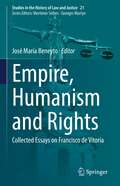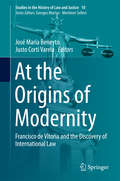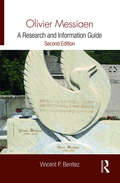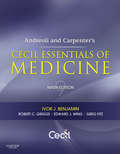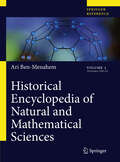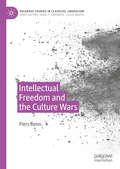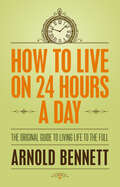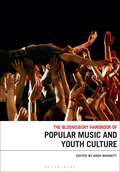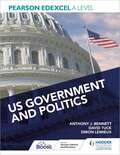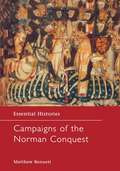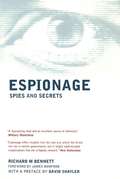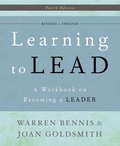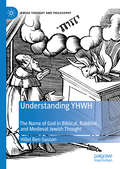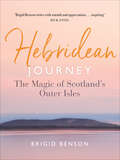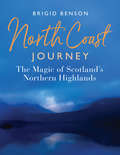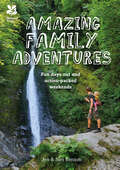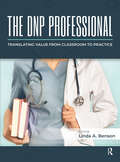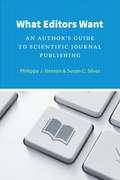- Table View
- List View
Phytomedicines, Herbal Drugs, and Poisons
by Ben-Erik van Wyk, Michael WinkPlants have been used to treat disease throughout human history. On a clay slab that dates back approximately five thousand years, the Sumerians recorded medicinal recipes that made use of hundreds of plants, including poppy, henbane, and mandrake. During the Middle Ages, monks commonly grew and prescribed plants such as sage, anise, and mint in their monasteries. And as the market for herbal remedies and natural medicine grows, we continue to search the globe for plants and plant compounds to combat our various ailments. In Phytomedicines, Herbal Drugs, and Poisons, Ben-Erik van Wyk offers a richly illustrated, scientific guide to medicinal and poisonous plants, including those used for their mind-altering effects. Van Wyk covers approximately 350 species—from Aloe vera and Ephedra sinica to Cannabis sativa and Coffea arabica—detailing their botanical, geographical, pharmacological, and toxicological data as well as the chemical structures of the active compounds in each. Readers learn, for example, that Acacia senegal, or gum acacia, is used primarily in Sudan and Ethiopia as a topical ointment to protect the skin and mucosa from bacterial and fungal infections, and that Aconitum napellus, more commonly known as aconite, is used in cough syrups but can be psychedelic when smoked or absorbed through the skin. With 350 full-color photographs featuring the plants and some of their derivative products, Phytomedicines, Herbal Drugs, and Poisons will be an invaluable reference not only for those in the health care field but also for those growing their own medicinal herb gardens, as well as anyone who needs a quick answer to whether a plant is a panacea or a poison.
Empire, Humanism and Rights: Collected Essays on Francisco de Vitoria (Studies in the History of Law and Justice #21)
by José María BeneytoThis book deals with Vitoria, Charles V and Erasmus. Vitoria’s ideas had a major influence on Charles V and his European and American policy. In turn, Erasmus’ humanism was decisive in the formation of a new international order intellectually discussed by Vitoria and put into practice by the Emperor.Shedding new light on the influence of Francisco de Vitoria and Erasmus on Charles V’s imperial policy, the book’s goal is to explore the impact of Vitoria’s thought with regard to the history of, and contemporary issues in, international law, while also comparing his thinking with that of the well-known humanist Erasmus and assessing their respective influences on the imperial policy of Charles V.
At the Origins of Modernity: Francisco de Vitoria and the Discovery of International Law (Studies in the History of Law and Justice #10)
by José María Beneyto Justo Corti VarelaThis book is based on an international project conducted by the Institute for European Studies of the University CEU San Pablo in Madrid and a seminar on Vitoria and International Law which took place on July 2nd 2015 in the convent of San Esteban, the place where Vitoria spent his most productive years as Chair of Theology at the University of Salamanca. It argues that Vitoria not only lived at a time bridging the Middle Ages and Modernity, but also that his thoughts went beyond the times he lived in, giving us inspiration for meeting current challenges that could also be described as “modern” or even post-modern.There has been renewed interest in Francisco de Vitoria in the last few years, and he is now at the centre of a debate on such central international topics as political modernity, colonialism, the discovery of the “Other” and the legitimation of military interventions. All these subjects include Vitoria’s contributions to the formation of the idea of modernity and modern international law.The book explores two concepts of modernity: one referring to the post-medieval ages and the other to our times. It discusses the connections between the challenges that the New World posed for XVIth century thinkers and those that we are currently facing, for example those related to the cyberworld. It also addresses the idea of international law and the legitimation of the use of force, two concepts that are at the core of Vitoria’s texts, in the context of “modern” problems related to a multipolar world and the war against terrorism. This is not a historical book on Vitoria, but a very current one that argues the value of Vitoria’s reflections for contemporary issues of international law.
Olivier Messiaen: A Research and Information Guide (Routledge Music Bibliographies)
by Vincent BenitezOlivier Messiaen: A Research and Information Guide, Second Edition presents researchers with the most significant and helpful resources on Olivier Messiaen, one of the twentieth century's greatest composers. With multiple indices, this annotated bibliography will serve as an excellent tool for librarians, researchers, and scholars sorting through the massive amount of material in the field. The second edition has been fully revised and updated.
Olivier Messiaen: A Research and Information Guide (Routledge Music Bibliographies)
by Vincent BenitezOlivier Messiaen: A Research and Information Guide, Second Edition presents researchers with the most significant and helpful resources on Olivier Messiaen, one of the twentieth century's greatest composers. With multiple indices, this annotated bibliography will serve as an excellent tool for librarians, researchers, and scholars sorting through the massive amount of material in the field. The second edition has been fully revised and updated.
Andreoli and Carpenter's Cecil Essentials of Medicine E-Book: Andreoli And Carpenter's Cecil Essentials Of Medicine (Cecil Medicine)
by Ivor Benjamin Robert C. Griggs Thomas E. Andreoli J. Gregory FitzStudents, residents, and instructors swear by Andreoli and Carpenter’s Cecil Essentials of Medicine because it presents just the right amount of information, just the right way. Edited by the late Thomas E. Andreoli, MD as well as Ivor Benjamin, MD, Robert C. Griggs, MD, and Edward J. Wing, MD, it focuses on core principles and how they apply to patient care, covering everything you need to know to succeed on a medical rotation or residency. Masterful editing and a user-friendly full-color design make absorbing and retaining information as effortless as possible. New chapters on "Pre- and Post-Operative Care" and "Palliative Care," plus the integration of molecular biology and other new horizons in medicine, familiarize you with the most current clinical concepts. An expanded International Editorial Board provides increased input from respected practitioners worldwide. Excellent images and clinical photographs vividly illustrate the appearance and clinical features of disease. Masterful editing and a user-friendly full-color design make absorbing and retaining information as effortless as possible.
Dopamine: Endocrine and Oncogenic Functions
by Nira Ben-JonathanDopamine is a small molecule traditionally regarded as a brain-derived neuronal modulator implicated in many neurological and psychiatric disorders. Outside the brain, dopamine fulfills all the criteria of a circulating hormone which affects normal and abnormal functions of multiple organs and regulatory systems and is also involved in many aspects of cancer formation and progression. This book provides a much needed systematic account of dopamine as an endocrine and autocrine/paracrine hormone and fills a major gap in the overall understanding of the production, distribution and actions of this very important molecule. Key Features: Explores the many different faces of dopamine as autocrine, paracrine and endocrine molecule Documents the adverse effects of antipsychotics on dopamine functions Reviews the many ways dopamine affects the cardiovascular, renal and reproductive systems Provides updates on receptor oligomerization and signaling Examines the role of dopamine in tumorigenesis Related Titles Jones, S. ed. Dopamine - Glutamate Interactions in the Basal Ganglia (ISBN 978-0-3673-8197-4) Luo, L. Principles of Neurobiology (ISBN 978-0-8153-4494-0) Sidhu, A. et al., eds. Dopamine Receptors and Transporters (ISBN 978-0-8247-0854-2)
Dopamine: Endocrine and Oncogenic Functions
by Nira Ben-JonathanDopamine is a small molecule traditionally regarded as a brain-derived neuronal modulator implicated in many neurological and psychiatric disorders. Outside the brain, dopamine fulfills all the criteria of a circulating hormone which affects normal and abnormal functions of multiple organs and regulatory systems and is also involved in many aspects of cancer formation and progression. This book provides a much needed systematic account of dopamine as an endocrine and autocrine/paracrine hormone and fills a major gap in the overall understanding of the production, distribution and actions of this very important molecule. Key Features: Explores the many different faces of dopamine as autocrine, paracrine and endocrine molecule Documents the adverse effects of antipsychotics on dopamine functions Reviews the many ways dopamine affects the cardiovascular, renal and reproductive systems Provides updates on receptor oligomerization and signaling Examines the role of dopamine in tumorigenesis Related Titles Jones, S. ed. Dopamine - Glutamate Interactions in the Basal Ganglia (ISBN 978-0-3673-8197-4) Luo, L. Principles of Neurobiology (ISBN 978-0-8153-4494-0) Sidhu, A. et al., eds. Dopamine Receptors and Transporters (ISBN 978-0-8247-0854-2)
Intellectual Freedom and the Culture Wars (Palgrave Studies in Classical Liberalism)
by Piers BennThis book offers a sustained and vigorous defence of free expression and objective enquiry situated in the context of the current culture wars. In the spirit of J. S. Mill, Benn investigates objections to the ideal of free expression in relation to harm and offence, reaching broadly liberal conclusions with reference to recent examples of attempts to curb free speech on university campuses. Accepting that some expressions can cause non-physical harm, Benn also considers objections to free speech based on certain understandings of power and privilege. In its exploration and rejection of arguments against the possibility of obtaining objective truth, the book navigates hotly contested fields of contemporary debate, including feminism and identity politics. It challenges the dogma of social constructionism and examines current notions of identity, arguing that a case for fairness can be made without appealing to them. Offering a qualified endorsement of friendship between ideological opponents, Benn highlights common obstacles to civil and rational discussions, concluding with a rational, moral, and broadly spiritual solution to the cultural combat that monopolises present-day society.
How to Live on 24 Hours a Day: The Original Guide to Living Life to the Full
by Arnold BennetRead the original guide to living life to the full and making every hour count in this classic twentieth-century self-help style volume. As you look back on the year that has just past, do you feel as though you spent another twelve months merely existing instead of truly living? Do you often go to bed at night with an anxious, sinking feeling that you wasted away another precious day? Originally published in 1910 and written by Arnold Bennett, How to Live on 24 Hours a Day argues time is the most precious resource you have and offers down-to-earth, practical advice about how to make the most of your day and how to strike the work life balance - an issue still at the forefront of modern society's concerns. The important lesson, according to Bennett, is to commit to carving out some time each day to do things that will really enrich your life and help you progress. Investing all your hours in a job you dislike; your routine consisting of getting up, going to work, coming home, unwinding and going to bed - Bennett argues that this is not living but simply existing. Bennett's solution is to make the most of the time either side of working hours, the commute, the evening hours, and that golden time, the weekend! Time can be spent in various pursuits, from literature, enjoying of the arts or even just time spent in reflection. This pioneering and original lifestyle and time management guide is succinctly and cleverly written in an easy-to-read and narrative style that readers will enjoy and find as useful today as it was a hundred years ago.
The Bloomsbury Handbook of Popular Music and Youth Culture (Bloomsbury Handbooks)
by Andy BennettThe Bloomsbury Handbook of Popular Music and Youth Culture provides a comprehensive and fully up-to-date overview of key themes and debates relating to the academic study of popular music and youth culture. While this is a highly popular and rapidly expanding field of research, there currently exists no single-source reference book for those interested in this topic. The handbook is comprised of 32 original chapters written by leading authors in the field of popular music and youth culture and covers a range of topics including: theory; method; historical perspectives; genre; audience; media; globalization; ageing and generation.
Pearson Edexcel A Level US Government and Politics
by Anthony J Bennett David Tuck Simon Lemieux Eric MageeThis fully updated Textbook for Pearson Edexcel A-level Politics will help your students develop a critical understanding of the latest developments in US Government and Politics. This trusted textbook by Anthony J Bennett, revised by David Tuck and Simon Lemieux, is specially designed to reflect the Edexcel specification and help your students approach complex topics with confidence. This Student Textbook:- Comprehensively covers the Government and Politics of the USA, including the 2020 Presidential elections- Places recent developments in a historical context throughout to show the influence of political history on current events- Builds your confidence by highlighting key terms and explaining synoptic links between different topics in the specification- Develops your analysis and evaluation skills through activities, debates and practice questions- Provides answer guidance for practice questions online at www.hoddereducation.co.uk
Campaigns of the Norman Conquest (Essential Histories #12)
by Matthew BennettFirst Published in 2003. Routledge is an imprint of Taylor & Francis, an informa company.
Campaigns of the Norman Conquest (Essential Histories)
by Matthew BennettFirst Published in 2003. Routledge is an imprint of Taylor & Francis, an informa company.
Espionage: Spies and Secrets
by Richard BennettThe need to defend against terrorist outrages has drawn unprecedented public attention to modern-day global espionage, from the US government's involvement in the politics of the Middle East, Europe and Africa, to the surveillance of their own citizens by governments throughout the western world. This compelling reference resource contains over 500 entries covering every aspect of modern-day intelligence-gathering and counter-terrorism, along with a comprehensive overview of its history. Global in scope, Espionage focuses in particular on developments in the field of intelligence since the end of the Cold War:-Governmental failure to foresee recent terrorist attacks against western targets-Counter-Terrorism, including the growth in commercial terrorism-Electronic and communications surveillance-Illegal activities by the intelligence services from around the world, including assassination, smuggling and torture-Terminology and equipment explainedWith entries on individual spies, politicians and diplomats, from the players to the patsies, and profiles of the key historical events and scandals from the history of spying, Espionage is the ultimate guide for journalists, researchers and anyone with an interest in this highly topical, controversial and chilling subject.
Interceptive Actions in Sport: Information and Movement
by Simon Bennett Keith Davids Geert J. P. Savelsbergh John Van Der KampDynamic interceptive actions are those actions for which the body, or an implement, must be moved into the right place at the right time in order to accomplish a task. These actions are particularly prevalent in sport, for example reaching to catch a ball or running towards a target to make a tackle. This book is the first to offer a comprehensive review of existing theoretical research on dynamic interceptive actions, as well as close examination of specific, practical applications. The book includes material on: * catching * wielding tennis rackets * putting in golf * controlling and kicking a soccer ball. It is essential reading for anybody with a close interest in motor learning and control or skill acquisition, and will be of interest to students of sport psychology, movement science and coaching science.
Learning to Lead: A Workbook on Becoming a Leader
by Warren Bennis Joan GoldsmithFrom leadership expert Warren Bennis, a workbook to help anyone reach their full potential as a leader Warren Bennis and Joan Goldsmith maintain that leaders are not born, they are made-in fact, anyone can develop the skills to transform their lives and their organizations. In Learning to Lead, these leadership experts have created a program that enables students, staff, managers, executives, public servants, and professionals to discover their own leadership voice.In these pages Bennis and Goldsmith offer the wisdom of world leaders, tools for self-assessment, and exercises for building leadership skills. These lessons enable readers to recognize false leadership myths, translate failures into springboards for creativity, and communicate personal visions that inspire others to produce extraordinary results. An immensely useful workbook and a powerful reformulation of the nature of leadership, Learning to Lead is an invaluable guide to driving your own success and inspiring it in others.
Understanding YHWH: The Name of God in Biblical, Rabbinic, and Medieval Jewish Thought (Jewish Thought and Philosophy)
by Hillel Ben-SassonThis book unlocks the Jewish theology of YHWH in three central stages of Jewish thought: the Hebrew bible, rabbinic literature, and medieval philosophy and mysticism. Providing a single conceptual key adapted from the philosophical debate on proper names, the book paints a dynamic picture of YHWH’s meanings over a spectrum of periods and genres, portraying an evolving interaction between two theological motivations: the wish to speak about God and the wish to speak to Him. Through this investigation, the book shows how Jews interpreted God's name in attempt to map the human-God relation, and to determine the measure of possibility for believers to realize a divine presence in their midst, through language.
Hebridean Journey: The Magic of Scotland’s Outer Isles
by Brigid BensonWashed by the surging waves of the Atlantic Ocean, the island chain of the Outer Hebrides lies at the very edge of Europe. This richly illustrated book is a fabulous invitation to discover the distinct character of each of the islands, covering Lewis and Harris, Berneray, Grimsay, North Uist, Benbecula, South Uist, Eriskay, Barra and Vatersay, and the vibrant Gaelic culture of the islanders.From white shell sands, peaty moors and gnarly mountains to heather hills, sea-green lochs and mysterious ancient monuments, these are places of unrivalled beauty which are also home to a huge variety of wildlife on land, at sea and in the air – otters, red deer, orca, dolphins, sea eagles, grey seals and corncrake, to name but a few.Packed with outstanding experiences, fascinating insights, hidden gems and helpful information, Hebridean Journey creates the uplifting opportunity of meaningful travels and life affirming experiences in the unique magic of Scotland’s Atlantic islands.
North Coast Journey: The Magic of Scotland’s Northern Highlands - As seen on Jeremy Clarkson's 'Grand Tour'
by Brigid BensonThis is the essential guide to the north of Scotland, on a route which begins in Inverness, weaves westwards to Applecross and then northwards towards Torridon. From Ullapool it leads to the most northerly points in Britain, passing by Caithness and John o’ Groats before heading south again through Dingwall and to Inverness.In addition to stunning mountains, moors, lochs and beaches, the route also featuresexquisite towns and villages, castles, distilleries, breweries, natural wonders and wildlife.Brigid Benson, who knows the road intimately, divides the route into manageable chunks, suggesting where to discover history, observe wildlife, meet great local characters, shop at quirky stores, taste outstanding food, drink in friendly bars and cafes, stand in awe of amazing sights, and recommending places to picnic, swim, surf, walk and stargaze. And great places to camp and stay. She also draws attention to attention to potential pitfalls, offering useful advice on single-track roads, fuel, car problems, planning realistic itineraries, and much more.
Amazing Family Adventures
by Jen Benson Sim BensonWhether orienteering, building dens or making a house for a hedgehog, this guide is the ideal way for all the family to interact with wildlife and nature and find adventures in wild places.
The DNP Professional: Translating Value from Classroom to Practice
by Linda BensonThe DNP Professional: Translating Value from Classroom to Practice is a collection of exemplars from DNP (Doctor of Nursing Practice) -prepared experts across various advanced practice nursing roles and settings. The content illustrates the application of the American Association of Colleges of Nursing’s “Essentials,” quantifies successful DNP-prepared practitioner outcomes, and describes the overall impact of the nursing practice doctorate. Each chapter is written by a different expert and focuses on how the Essentials relate to that author’s role, including business planning, evidence-driven decision making, data analytics, and interprofessional collaboration. These leaders demonstrate how to implement lessons learned in a DNP program and translate them into everyday practice in every nursing domain, with plenty of pearls to pass along. Editor Linda A. Benson has divided the book into sections based on roles and settings: • Nurse Practitioner • Clinical Nurse Specialist • Certified Registered Nurse Anesthetists • Nurse Midwife • Nurse Executive • Academia • Population Health • Informatics • Legislative Activity When performing at their peak, DNPs can affect clinical, satisfaction, and cost outcomes, as well as provide preceptorship and mentoring. With exemplars from across the continuum of practice sites and roles, The DNP Professional: Translating Value from Classroom to Practice enables both students and DNP graduates to optimize the curricular Essentials in the practice setting.
The DNP Professional: Translating Value from Classroom to Practice
by Linda BensonThe DNP Professional: Translating Value from Classroom to Practice is a collection of exemplars from DNP (Doctor of Nursing Practice) -prepared experts across various advanced practice nursing roles and settings. The content illustrates the application of the American Association of Colleges of Nursing’s “Essentials,” quantifies successful DNP-prepared practitioner outcomes, and describes the overall impact of the nursing practice doctorate. Each chapter is written by a different expert and focuses on how the Essentials relate to that author’s role, including business planning, evidence-driven decision making, data analytics, and interprofessional collaboration. These leaders demonstrate how to implement lessons learned in a DNP program and translate them into everyday practice in every nursing domain, with plenty of pearls to pass along. Editor Linda A. Benson has divided the book into sections based on roles and settings: • Nurse Practitioner • Clinical Nurse Specialist • Certified Registered Nurse Anesthetists • Nurse Midwife • Nurse Executive • Academia • Population Health • Informatics • Legislative Activity When performing at their peak, DNPs can affect clinical, satisfaction, and cost outcomes, as well as provide preceptorship and mentoring. With exemplars from across the continuum of practice sites and roles, The DNP Professional: Translating Value from Classroom to Practice enables both students and DNP graduates to optimize the curricular Essentials in the practice setting.
What Editors Want: An Author's Guide to Scientific Journal Publishing (Chicago Guides to Writing, Editing, and Publishing)
by Philippa J. Benson Susan C. SilverResearch publications have always been key to building a successful career in science, yet little if any formal guidance is offered to young scientists on how to get research papers peer reviewed, accepted, and published by leading scientific journals. With What Editors Want, Philippa J. Benson and Susan C. Silver, two well-respected editors from the science publishing community, remedy that situation with a clear, straightforward guide that will be of use to all scientists. Benson and Silver instruct readers on how to identify the journals that are most likely to publish a given paper, how to write an effective cover letter, how to avoid common pitfalls of the submission process, and how to effectively navigate the all-important peer review process, including dealing with revisions and rejection. With supplemental advice from more than a dozen experts, this book will equip scientists with the knowledge they need to usher their papers through publication.

